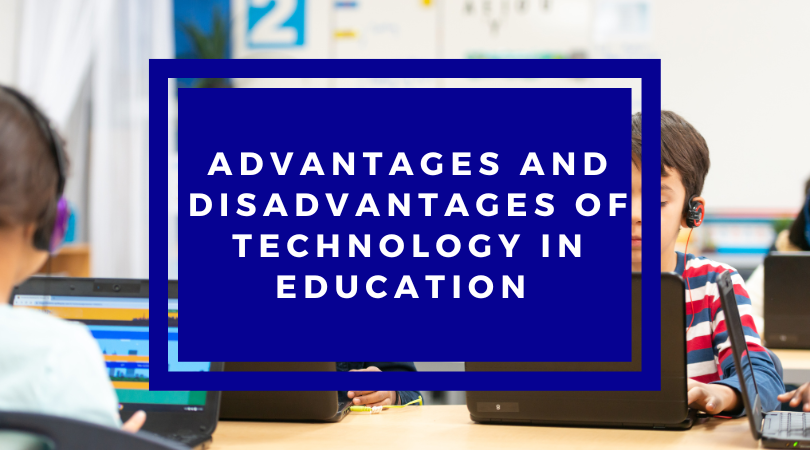Advantages and Disadvantages of Technology in Education

In today’s digital era, technology has become an integral part of our lives, transforming the way we learn, work, and interact. This means that there are some advantages and disadvantages of technology in education. Its influence is especially pronounced in educational settings, where devices like iPads, Chromebooks, and the emergence of Artificial Intelligence (AI) have revolutionized the traditional classroom experience. While these technological advancements bring numerous benefits, they also present certain drawbacks. In this blog post, we will explore eight advantages and disadvantages of technology in education.
This post may contain affiliate links for full disclosure click here
Advantages of Technology in Education:
Access to vast educational resources:
One of the greatest advantages of incorporating technology is its instant access to a wealth of educational resources. iPads and Chromebooks enable students to explore online libraries, educational apps, interactive multimedia, and virtual simulations. This access to a broad range of content enhances students’ engagement, encourages independent learning, and facilitates research on various subjects.
Some of the online libraries that I like to use for digital products are Boom Cards and Teachers Pay Teachers. I have stores on both platforms with many different digital resources. To start you on your digital products journey, I give some digital products to my email subscribers. Click the link below to sign up for my email list and get a digital writing activity that will have your students expressing creativity while working on their digital and writing skills.
Individualized learning opportunities:
Technology facilitates personalized learning experiences tailored to students’ individual needs and learning styles. With adaptive learning software and AI-powered tools, teachers can customize educational content and assessments based on students’ abilities and progress. This individualized approach helps students grasp concepts at their own pace, boosting their confidence and academic performance.
Collaborative and interactive learning:
Technology promotes collaborative and interactive learning environments. Students can collaborate on projects, share ideas, and engage in discussions using online platforms and tools. iPads and Chromebooks allow for real-time collaboration, fostering teamwork and communication skills. Moreover, interactive applications and simulations enhance student participation and make abstract concepts more tangible and understandable.
One great way to encourage collaborative learning in a digital environment is through digital escape rooms. Often times these digital escape rooms can be made or purchased to work with the Google suite of tools which allows for great collaboration among students. I have two great digital escape rooms that will have students working together to master math skills and really be able to succeed with the advantages of technology in education.
Enhancing digital literacy skills:
Integrating technology into the classroom equips students with essential digital literacy skills necessary for their future success. Students become proficient in using various software, online tools, and applications, improving their technological competence. These skills are increasingly valuable in the modern job market, where digital literacy is a prerequisite in almost every field.
Want to read more?!?!
Disadvantages of Technology in Education:
Distractions and potential misuse:
The presence of technology devices can create distractions in the classroom. Students may be tempted to engage in non-educational activities, such as social media browsing or gaming. Moreover, the misuse of technology, such as cyberbullying or accessing inappropriate content, poses challenges for educators in maintaining a safe and focused learning environment.
Overdependence on technology:
Relying heavily on technology devices may hinder the development of critical thinking and problem-solving skills. Students may become overly dependent on digital tools for information and fail to cultivate essential cognitive abilities. Teachers should strike a balance between using technology as a learning aid and encouraging independent thinking and analytical skills.
This is often what I try to do in my essay writing classes on Outschool. To encourage students to use the technology available to them to research their essays and to help them grammar check their essays, but also to encourage their voice to come out in their writing and to think critically about the issue and prompt that we are working on. To check out my part one essay class click here.
Potential inequalities and access issues:
Not all students have equal access to technology outside the classroom, which can exacerbate existing educational inequalities. Lack of access to devices, internet connectivity, or adequate technical support can hinder students’ ability to fully benefit from technology-enabled learning. Schools must ensure equitable access to technology resources for all students to bridge the digital divide.
Reduced physical interaction and social skills:
The increased use of technology in the classroom may inadvertently diminish face-to-face interactions and hinder the development of crucial social skills. Students might spend less time engaging in direct communication with their peers and teachers, potentially impacting their ability to collaborate, express ideas, and develop interpersonal skills.
Technology undoubtedly offers numerous advantages in educational settings, revolutionizing the learning experience. From improved access to resources and personalized learning opportunities to fostering collaboration and digital literacy skills, technology has the potential to enhance education significantly. However, it is vital to address the potential downsides, such as distractions, over-dependence, and access issues. You have to look at both the advantages and disadvantages of technology in education to make informed choices about how to use technology in your classroom. Also, considering the drawbacks helps you overcome them.
If you enjoyed this blog post please consider sharing it so others can benefit as well.





thanks for this